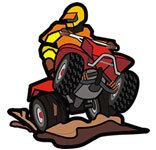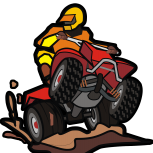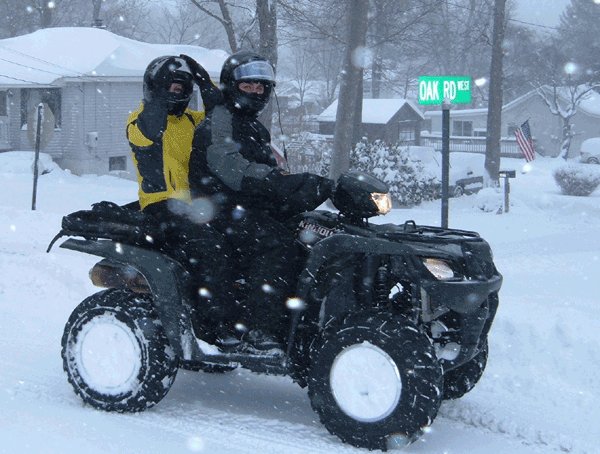Leaderboard
Popular Content
Showing content with the highest reputation on 06/04/2023 in Posts
-
I live in SW Michigan and admittedly am a little late in joining a forum. Currently I own a 2000 Yamaha 250 Bear Tracker which I bought brand new way back in 2000. Over the years I've taken it to off road parks such as Badlands in Indiana and a place near me called "Kids in the mud. For the last five years the machine has been sitting but lately, I've caught the "bug" again and have been in the process of riding again. I'm also seriously looking at UTV's so my wife and I can both ride, but more on that later. At the time I bought the ATV,my budget only permitted a 250cc machine. People were telling me "You'll be sorry if you buy a 2-wheel drive machine." Since then, I've never had any problems except in heavy wet snow. Anyway, I'm happy to be here and am looking forward to maintenance tips and what others are saying about UTV's1 point
-
The United States military operates on the forefront of technological advancements, and when it comes to conquering challenging terrains, the employment of All-Terrain Vehicles (ATVs) and Utility Task Vehicles (UTVs) has proven to be indispensable. These robust vehicles provide the military with enhanced mobility, agility, and versatility across a variety of operational scenarios. In this article, we will delve into how and what ATVs and UTVs the US military employs, highlighting their crucial role in modern warfare. 1. Enhanced Mobility: ATVs and UTVs play a vital role in improving the mobility of the US military, allowing forces to traverse diverse terrains efficiently. These vehicles are often equipped with four-wheel drive capabilities, high ground clearance, and powerful engines, enabling them to conquer challenging landscapes such as deserts, mountains, forests, and even snow-covered regions. The military harnesses their maneuverability to transport troops, equipment, and supplies swiftly across the battlefield, reducing response times and increasing operational efficiency. 2. Tactical Deployment: ATVs and UTVs offer the US military the ability to rapidly deploy forces to critical locations. Compact and lightweight designs allow for easy transport via air or land, enabling quick insertion of troops into remote and inaccessible areas. This feature is particularly valuable for special operations forces, facilitating stealthy and rapid assaults, reconnaissance missions, and target acquisitions. 3. Versatility and Adaptability: The US military employs a wide array of ATVs and UTVs, each specifically designed to meet diverse operational requirements. One such vehicle is the Polaris MRZR (Military RZR), which has become a staple in the US military's inventory. The MRZR features multiple variants, including two-seat and four-seat configurations, and offers customization options for different mission needs. These vehicles can be armed with weapons, equipped with communication systems, or used for casualty evacuation, command and control, and cargo transportation. 4. Specialized Operations: Beyond traditional combat roles, ATVs and UTVs have proven invaluable in specialized military operations. The US military utilizes modified and specialized variants, such as the Can-Am Outlander Max ATV and the Yamaha Wolverine X4 UTV, for specific purposes. These vehicles are often equipped with accessories like racks, winches, and cargo carriers to support activities such as surveillance, intelligence gathering, and explosive ordnance disposal (EOD). The ability to navigate off-road with agility allows troops to access areas that are otherwise challenging to reach, providing a tactical advantage in various scenarios. 5. Training and Recreation: In addition to their operational deployment, ATVs and UTVs are also used for training purposes within the US military. These vehicles enable personnel to familiarize themselves with off-road driving techniques, enhance their situational awareness, and simulate realistic combat scenarios. Moreover, the military recognizes the importance of recreational activities for the well-being and morale of service members. ATVs and UTVs are utilized in organized recreational programs, offering soldiers an opportunity to unwind and build camaraderie during their downtime. Conclusion: The US military's utilization of ATVs and UTVs demonstrates their recognition of the importance of mobility, adaptability, and versatility in modern warfare. These vehicles enhance operational effectiveness, providing swift maneuverability across diverse terrains and enabling rapid deployments to critical locations. By employing a range of specialized variants, the military ensures that these vehicles can fulfill a wide spectrum of mission requirements, from combat operations to intelligence gathering and training exercises. As technology continues to advance, it is certain that ATVs and UTVs will remain essential assets, empowering the US military to conquer even the most challenging terrains with ease. Thoughts? Comment Below View full post1 point
-
Newbi, if you’re going to ride atv’s sooner or later you’ll have to learn to work them. I’m no expert but will share what I know with you. Just ask and if I know am willing to help out. Welcome to the forum1 point
-
Very impressive lineup, thanks for the info, Can -Am is really producing some nice rides.1 point
-
Thumbs up for Polaris, very impressive vehicle. Rugged and tough looking!1 point
-
Outstandin. Looks like ther will be much to learn. Thanks for the info.1 point
-
Moved your status update to a new topic. I'm assuming this is a Bayou 220. Without power, the green neutral light will not come on. Like you said, shift down and up one to get into neutral.1 point
-
@mehim I can appreciate you and your husband's lifestyle 😀, but we try to keep this site family friendly for all ages. I let the first pic on the couch slide but the next three images you posted (forum and gallery) are fully nude, which goes against our terms of service: https://www.quadcrazy.com/terms/ No exposed nipple, genitalia, etc., which is what flags them for removal.1 point
-
When it comes to all-terrain vehicles (ATVs), having the right tires can make a world of difference in performance and safety. ATV tires are designed to handle various terrains and conditions, and selecting the appropriate ones for your specific needs is crucial. In this article, we will provide you with a comprehensive guide on how to choose the right ATV tires, considering factors such as terrain, tire type, size, and tread pattern. Determine your terrain: The first step in selecting the right ATV tires is to consider the type of terrain you will be riding on most frequently. Different terrains require different tire designs to optimize performance. Here are some common terrain types and the corresponding tire suggestions: Mud: Opt for tires with aggressive tread patterns, wider spacing between lugs, and self-cleaning capabilities to provide maximum traction in muddy conditions. Sand: Look for paddle or scoop-shaped tires with a large surface area to provide floatation and prevent sinking in soft sand. Rocks: Choose tires with reinforced sidewalls and durable construction to resist punctures and withstand rough terrains. Trail/General Purpose: For mixed terrains, all-purpose tires with a balanced tread pattern that offer good traction and durability are ideal. Consider tire type: ATV tires come in different types to suit specific riding preferences and conditions. The main types include: All-Terrain (AT) Tires: These provide a good balance between on-road and off-road performance, making them versatile for various terrains. Mud Tires: Designed with aggressive treads and deep lugs, they excel in muddy and slippery conditions, offering excellent traction. Sand Tires: Featuring a paddle or scoop design, these tires provide optimal traction and floatation in sandy environments. Racing Tires: Specifically engineered for high-performance ATV racing, these tires offer enhanced grip and maneuverability on tracks and trails. Determine the tire size: The size of your ATV tires greatly impacts its performance. It is essential to consult your ATV's manual or manufacturer specifications to determine the correct tire size. The size is usually indicated by a combination of numbers such as tire width, aspect ratio, and rim diameter (e.g., 25x8-12). Ensure that the selected tire size matches your ATV's recommended specifications to avoid clearance issues and maintain optimal handling. Evaluate tread pattern: The tread pattern of ATV tires plays a vital role in traction, stability, and overall performance. Consider the following tread patterns based on your riding requirements: Aggressive Tread: Suitable for challenging terrains like mud, rocks, and deep trails, these tires feature large, deep lugs for increased traction. All-Purpose Tread: Ideal for general riding and mixed terrains, these tires have a more balanced tread pattern with moderate lugs for versatility. Knobby Tread: Combining elements of aggressive and all-purpose treads, knobby tires provide a good compromise for various terrains, offering decent traction without sacrificing ride comfort. Additional Factors to Consider: Tire Ply Rating: The ply rating indicates the tire's strength and durability. Higher ply ratings generally provide better resistance to punctures and sidewall damage. Tube or Tubeless: Determine whether your ATV requires tube or tubeless tires based on the rim and manufacturer specifications. Brand and Reviews: Research reputable tire brands known for their quality and durability. Read customer reviews and seek recommendations from experienced ATV riders to gauge performance and reliability. Choosing the right ATV tires is crucial for optimal performance, safety, and enjoyment during your off-road adventures. Assessing factors such as terrain, tire type, size, and tread pattern will help you make an informed decision. Remember to View full post1 point
This leaderboard is set to New York/GMT-04:00















